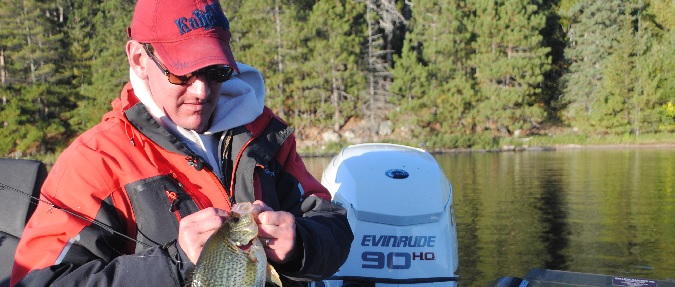
From now until the lakes freeze over, crappies can, in many bodies of water across the Midwest and elsewhere, be found in deep water. In some lakes, they might be in thirty feet of water right on the bottom, in other lakes deep they might be in fifteen feet of water. It depends on the lake or reservoir or pond that you’re fishing. The key is, find the crappies and they will be willing to eat your bait.
On lakes that don’t have a lot of structure, you can find crappies in the fall out in the basin of the lake. This is when a quality sonar unit comes into play. The fastest way to find the crappies in the basin of the lake is just to cruise around with an eye on the depth-finder. If there is structure available, they might be near it. If there is no structure, they’ll just be out there somewhere. Much of the time they’ll be right on the bottom, other times they might be up a little bit. Last fall on Kabetogama Lake in northern Minnesota I re-learned just how important sonar is when it comes to catching crappies(or any other species of fish when they’re in deep water). I was fishing with Kabetogama ace guide Travis Carlson. I’ve fished with Travis many times, always for walleyes. I’ve always been impressed with how much Travis relies on sonar to find and catch walleyes, but his dependence on sonar for crappies was even greater. These crappies were willing biters, but we had to be right on them: I mean right overhead. They were in water twenty seven to thirty feet deep, and they were tightly schooled. We were fishing from my boat. I had a Raymarine aSeries sonar with a nine inch screen on the console and a Dragonfly 7 on the bow. These units both draw an outstanding picture of whatever is below the boat. We were fishing vertically directly over the schools of crappies. We could see our sixteenth ounce jigs as we lowered them to the fish.
The important thing was, we had to be directly over the fish to get bit. Some of the schools were so tight that the sonar on the back of the boat revealed no fish, the sonar on the bow showed lots of fish. If you were fishing in the bow of the boat, you got bit. If you were in the back, nothing. Very quickly both of us were vertically jigging from the bow of the boat, and doubles were common.
Fire-Ball jigs, sixteenth ounce, color didn’t matter, tipped with a minnow or an Impulse Smelt Minnow shortened to about two inches were the deal. We lowered our baits until they were a foot or two above the fish. We softly quivered our rods to make the baits shake just a little bit. Usually the crappies would come up and eat them. After we caught a few, we needed to lower our baits to them a little more.
Travis also caught a good number of crappies on a live bait rig tipped with a minnow. Again, the bait needed to be up above the fish for success.
If you would like to catch some crappies from now until ice-up, look deep and you’ll probably be successful
To see all the most recent episodes of the Fishing the Midwest television series, new fishing related tips and fishing articles from the past, go to fishingthemidwest.com If you do Facebook, check us out for a variety of fishing related things.
by Bob Jensen
